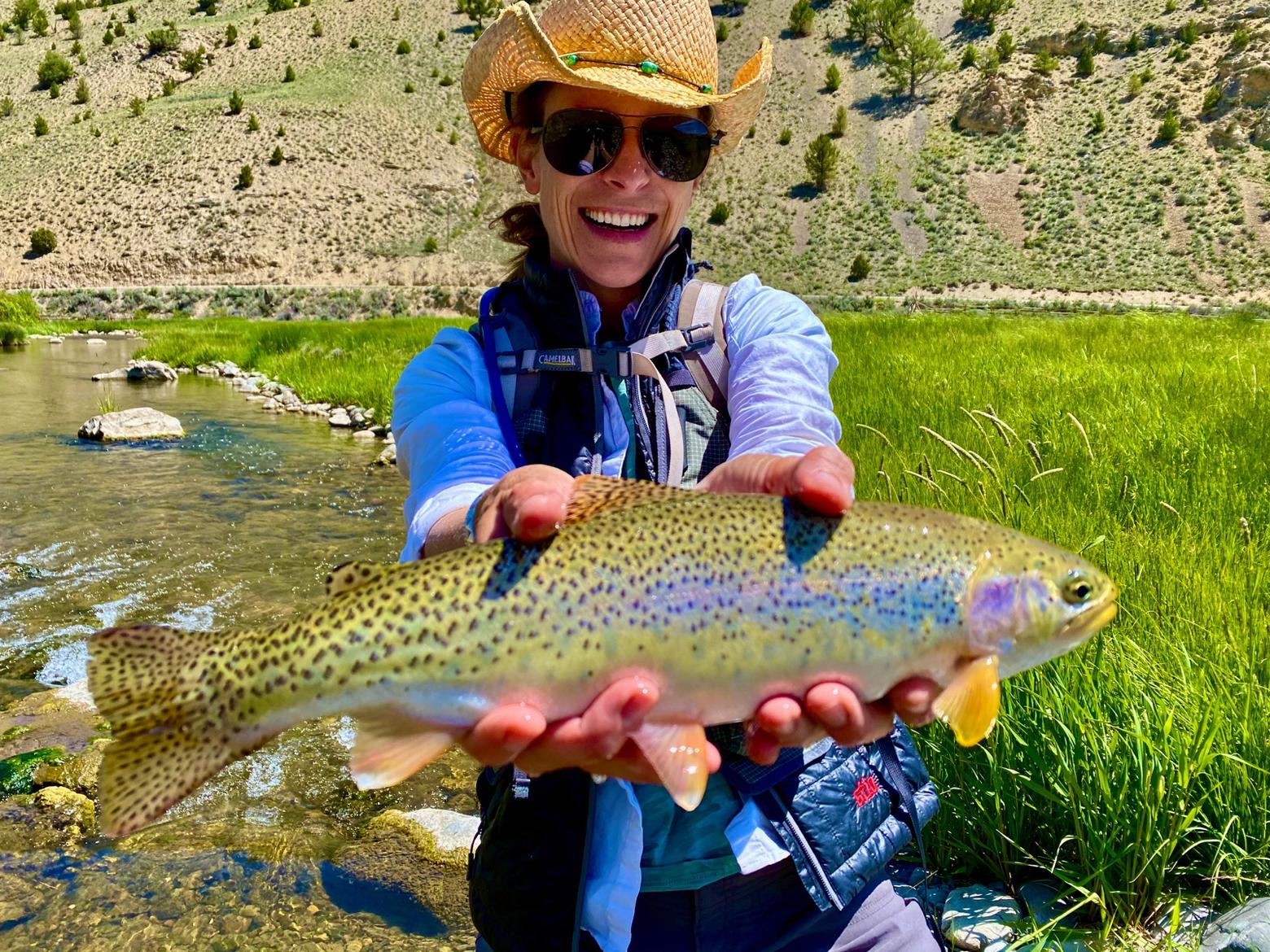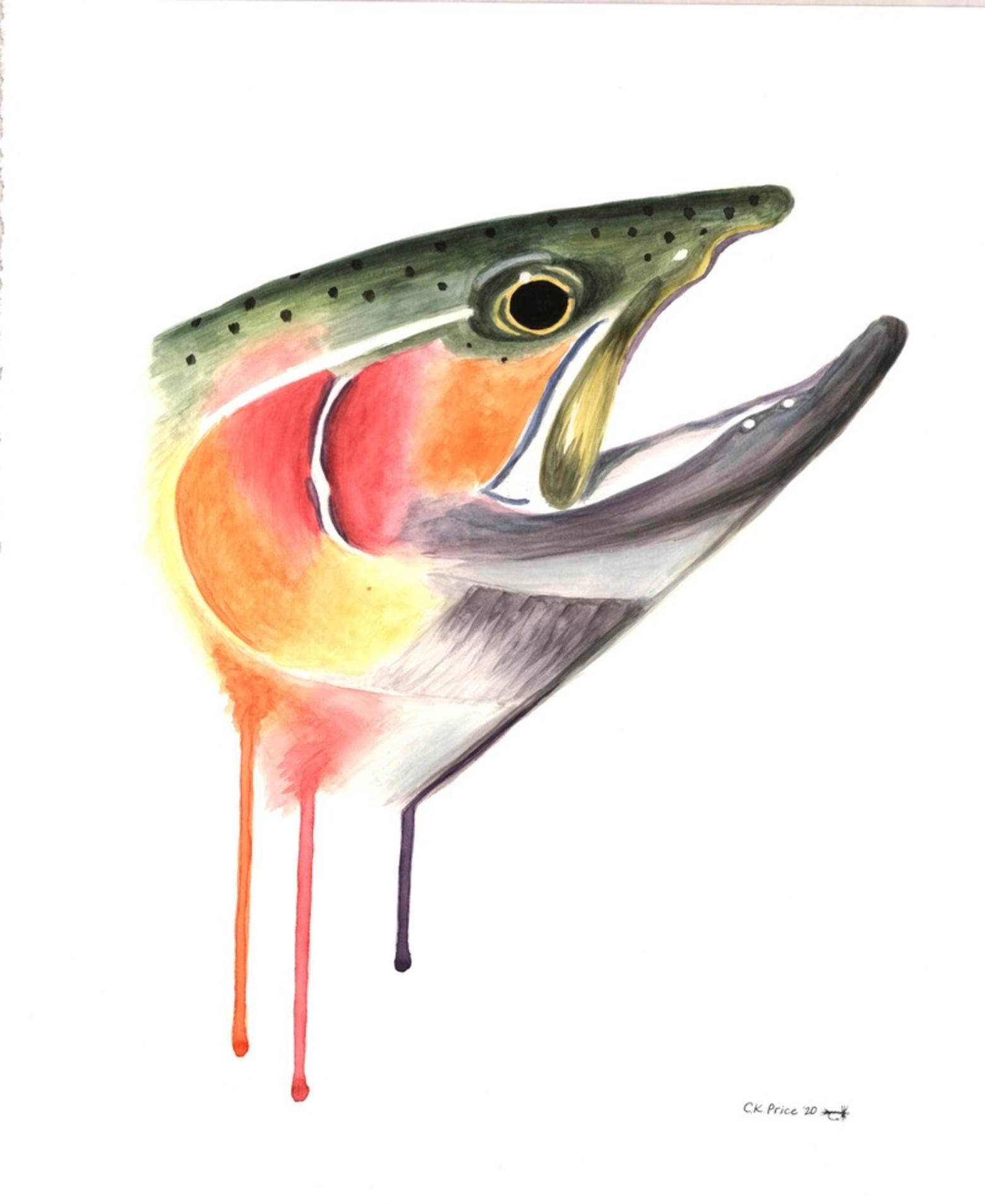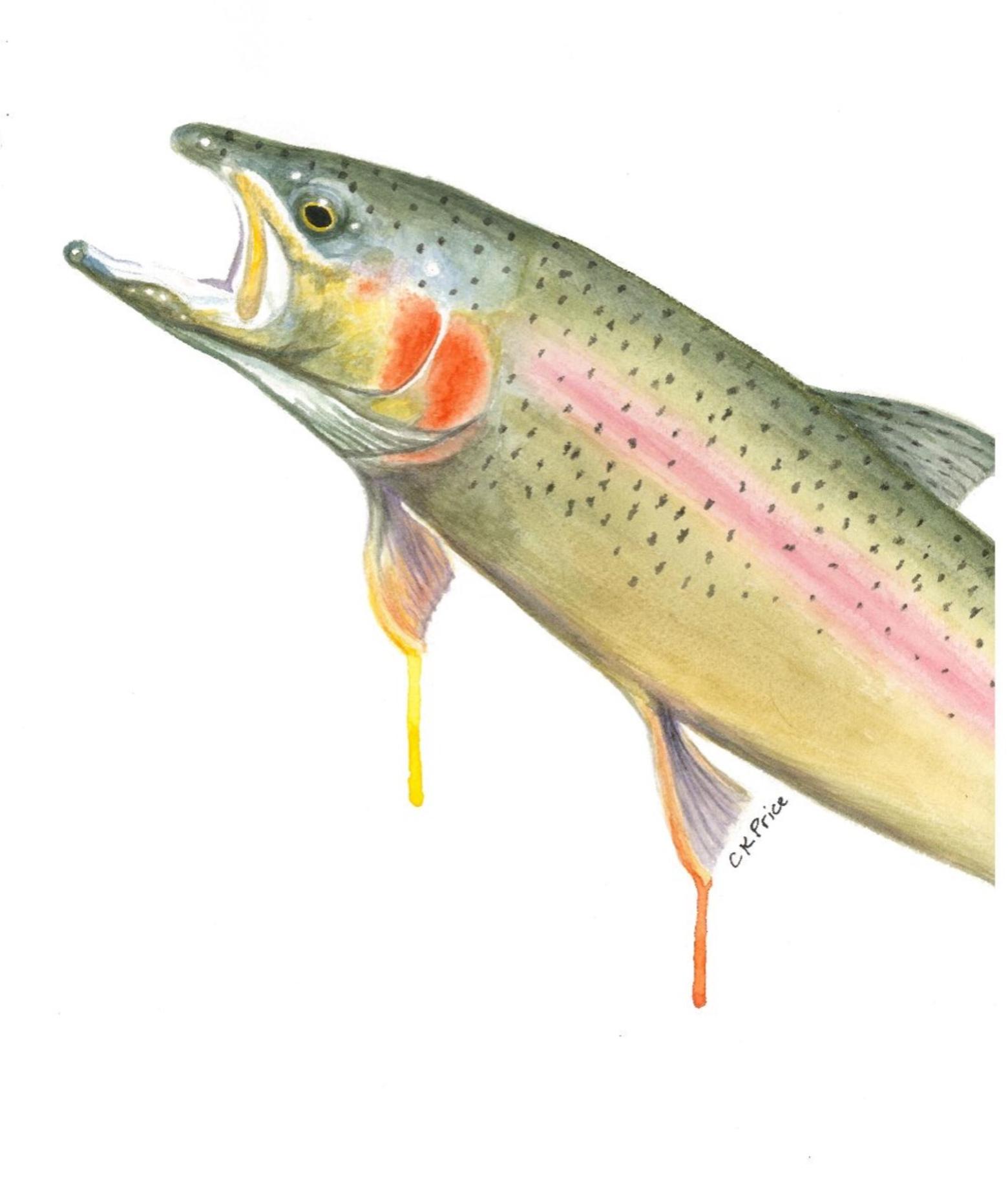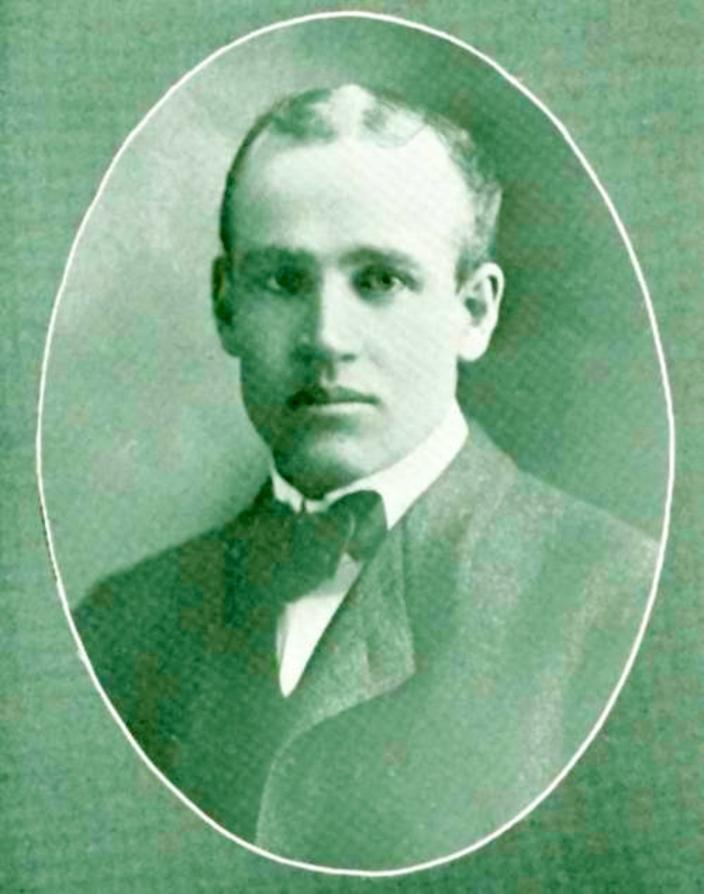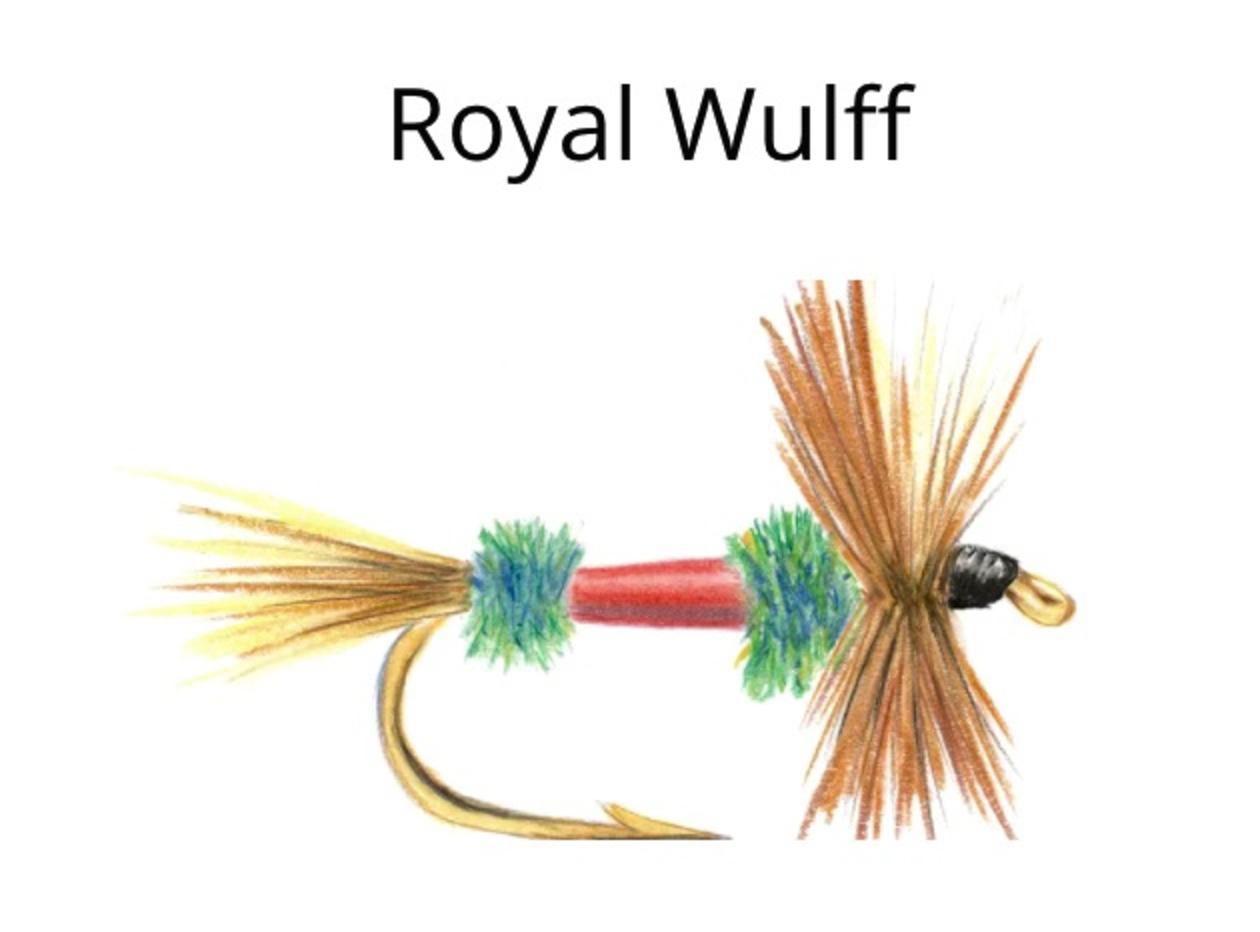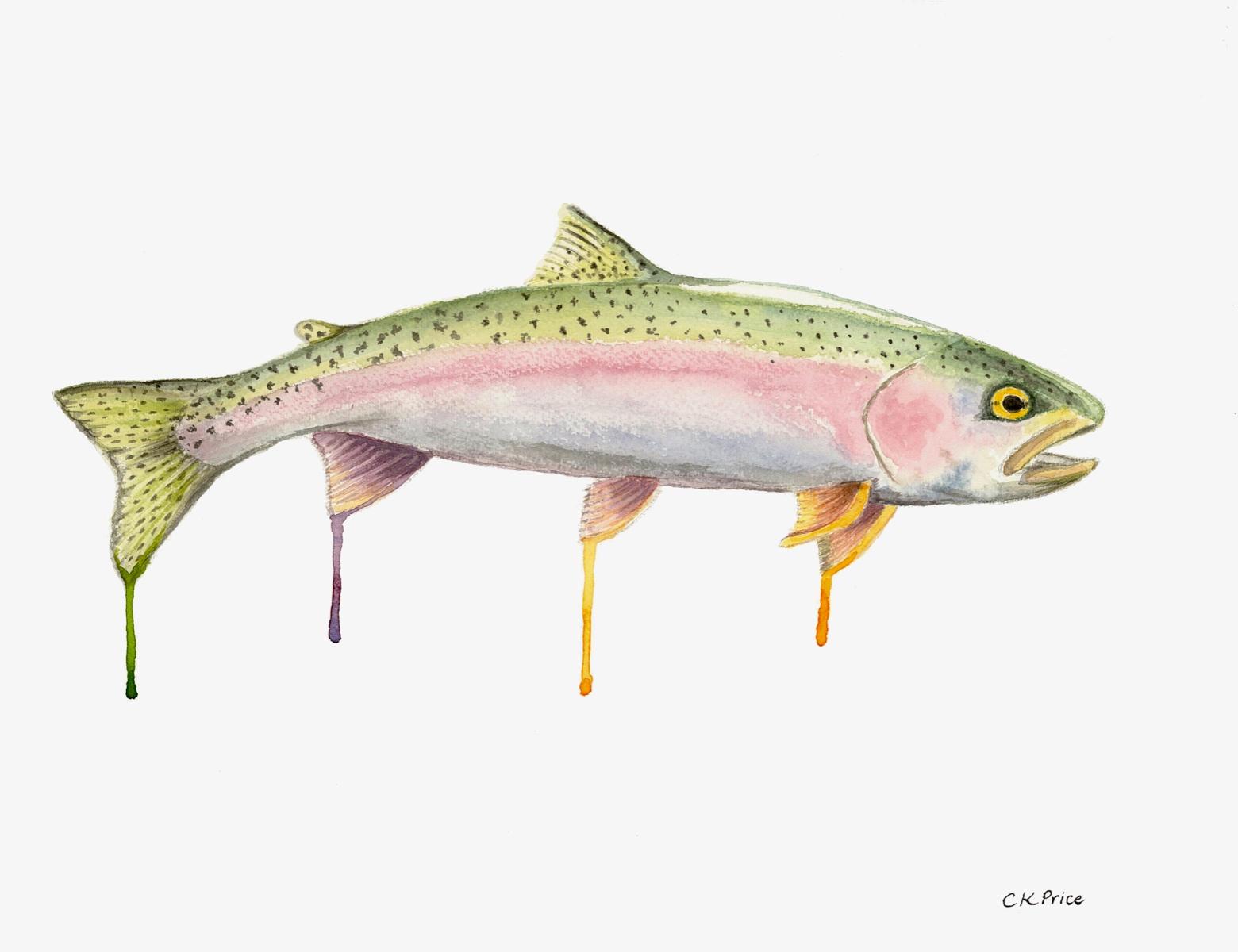Back to StoriesThe Watercolored Trout Of La Pescadera
In Español, which Caroline Price teaches as a second language when she’s not making art, she describes herself as la pescadora in referencing one of her favorite identities in the great outdoors. La pescadora—a fly-fisherwoman.
February 10, 2021
The Watercolored Trout Of La PescaderaCaroline Price's art has assumed greater meaning, reminding us of the things that matter most. She knows by personal experience
by Todd Wilkinson
In Español, which Caroline Price teaches as a second language when she’s not making art, she describes herself as la pescadora in referencing one of her favorite identities in the great outdoors. La pescadora—a fly-fisherwoman.
It’s a fine and joyous appellation to have for a person who lives in our part of the world; it also serves as a perfect segue for discussing Price’s art. What it doesn’t hint at is the career path she gave up, the-what-could've-been, choosing instead to have a quieter, less harried life in Montana where she and her husband could raise their sons away from the rat race.
Born in New York, Price’s family has truly historic Montana roots—of the real Horatio Alger rough and tumble kind that could only emanate from Butte. Every year when she was young the family would spend summers at Flathead Lake.
“We moved to Palm Beach, Florida when I was five, and while it is beautiful, it is a strange place to grow up. I would cry leaving Flathead Lake every summer; it felt more like home. I would tell friends in Palm Beach that I went camping, picked cherries off the tree and sold them on the side of the road, learned to shoot my brother's BB gun, and cleaned a fish when I was six years old, and they did not understand why I thought any of that was cool.”
"I would tell friends in Palm Beach that I went camping, picked cherries off the tree and sold them on the side of the road, learned to shoot my brother's BB gun, and cleaned a fish when I was six years old, and they did not understand why I thought any of that was cool.” —Caroline Price
During an overnight at Cold Lake in the summer before she started kindergarten, Price remembers a moment while her parents were setting up camp. “I caught several fish by myself on a spinning rod,” she says. “That is when dad taught me to fly fish.”
Paint brushes were also placed in her hands at an early age. “I took several art classes at The Hotchkiss School, where I went to boarding school in Connecticut. While I hoped to pursue art at Colorado College, my father urged me to take finance and economics classes. He had worked on Wall Street and that was his plan for me.”
She, however, carried her own compass.
Price went abroad, studying and living in Spain during her college years. When the time came to consider a career, she thought International Finance was an appealing way to land a good job in New York, using her fluency in Spanish and taking art classes on the side. Then a life-changing event happened.
“I was reunited with an old friend and classmate from Hotchkiss, Will Price, and we were married in 1997,” she says. “The common theme at our wedding was Montana. Will’s father’s family, like my own, also had Montana roots.”
In the case of Price's great-grandfather it is perhaps the kind of rags to riches immigrant tale you only see in the movies, rising from water boy for copper miners to owning a mansion in Butte and then becoming board chairman of the mighty Anaconda Company. (More on that in the question and answer section of this story, below).
The newlywed Prices spent a couple years in Evanston, Illinois while Will received his MBA at Northwestern University's vaunted Kellogg Business School. Job offers led them to fly over Montana en route to San Francisco. Their sons, Jack and Luke, were born in California and the family set out on trips into the Sierras where the boys learned to ski and fish—the latter, like their mother, first with spin-casting gear and then fly rods.
Recalling their own impressionable summers, Caroline and Will wanted the same for their kids. Fishing and hiking trips in Wyoming and Montana left them with a homesick feeling, like they needed to be here, she explains. While they loved the Bay and the excitement of the city, what they wanted more was a grounding alternative “where the rivers and the mountains could be part of our everyday life. We made a move to Bozeman and never looked back.”
They're the kind of couple who believes it is important to get involved and give back to the community.
On multiple levels, art is how Price expresses her yearning for deeper connection to the wonders of the Greater Yellowstone Ecosystem. Her father and brother were not dilletantes when it came to casting a fly. Reading water, understanding its flow, knowing where fish would be in a current, possessing the wherewithal of how to approach a stream without disturbing the trout—sensitivity and nuance, what some call ecological literacy, were nurtured.
That translates to how she thinks about fish as subjects. One upon a time, Price had her own mural business, painting in both acrylic and house paint on a large scale.
Today, with her sons grown up, she is back to her art again, rapidly expanding a body of work—watercolors mostly—devoted to celebrating trout and other wildlife-related themes. Will, meanwhile, is the founder and co-managing partner of Next Frontier Capital.
As a traumatic reminder that in Montana people are never far away from the power of nature, the Prices were among 30 families who lost homes in the Bridger Foothills wildfire that began near the M outside Bozeman over Labor Day weekend in 2020, went over the top of the ridge and raced up Bridger Canyon. Lost were photo albums containing family history and other irreplaceable objects, but emerging, more valuable, was a deeper meaning and appreciation for the fragile stuff that matters more—family, friends, and healthy environment, she says.
Not long ago, Mountain Journal asked Price about her art, her passion for conservation and what living in Montana means to her. You can see more of her paintings by clicking here.
MOUNTAIN JOURNAL: What was the first fish painting you ever made?
CAROLINE PRICE: My dad had a signed copy of the James Prosek book, "Trout, An Illustrated History" that I kept after he passed away. After visiting Roger Lang at the Sun Ranch in 2000, and fishing the Madison River, I was really impressed with Roger's effort to reintroduce the Westslope cutthroat to the Madison River. Later I copied Prosek's "Yellowstone Cutthroat Trout" and made it into notecards. I sent Roger a thank you note on that card. That was the first fish I painted, and I look back on that painting now and it is not very impressive.
MOJO: Tell us about those fascinating Montana roots that run through your family heritage. You have kinfolk who literally rose through the ranks the hard way.
PRICE: My father's family was in the copper mining industry in Butte and it is a great American immigrant story. My great-great grandfather, Jeremiah Kelley, immigrated to the US with his wife, Hannah Murphy, from Ireland in the 1870s. He worked with Marcus Daly in the silver mines of Mineral Hill, Nevada. Daly moved to Butte and they needed more help building mines, so he sent for Jeremiah Kelley, who came with his wife and son, Cornelius, then eight years old.
Cornelius, who went by "Con," was a water boy for the miners, making a dollar a day, but he was smart, stayed in school, and ended up going to University of Michigan Law School. There is a chance that either Anaconda Copper or Marcus Daly paid for his law school. He returned to Butte in 1898 and was elected Chief Deputy Attorney General of Silver Bow County. He had his own law practice for a short time, but soon joined Anaconda Copper Mining Co., rose in the ranks, and became company president in 1918, then Chairman of Anaconda in 1940. He remained in that role until he retired in 1957.
MOJO: How much of that time was in Montana and how much in New York?
PRICE: Kelley moved his wife and 5 daughters to New York after Anaconda Copper was listed on the New York Stock Exchange in 1917. While I never met my great-grandfather Con Kelley, I heard many stories of his remarkable career and also the beautiful Kootenai Lodge on Swan Lake that he and his business colleague, Orvis Evans, bought in 1910. It was an old hunting and fishing lodge, and it became a summer destination for my grandmother and her 4 sisters as well as the artist Charlie Russell. My father learned to fly fish on the little Johnson Creek that runs through the property into the Swan Lake.
MOJO: How is your art an expression of your values and identity as a conservationist?
PRICE: My art is an expression of my love of place—my love of Montana, where I learned to cherish the outdoors and the complex beauty of nature early in my childhood. I have used many different types of media over the years, but I find watercolors capture the bright, bold colors that we find in the spawning rainbow trout, or the delicate feather and shine on the bead head of the "Lil' Spanker" fly.
MOJO: Your work is both elegant and folksy. It also commemorates the favorite flies of friends, many of whom are giants in the conservation world of southwest Montana and the Greater Yellowstone Ecosystem. Tell us about it.
PRICE: I like to create an artistic study of the subject, to show the viewer the detail and work that is behind each handmade fly, or the brilliant colors and patterns in a trout that we only see for a few seconds before we release it back into the water. There is a long history of fly tying, and the flies all have a story of either how they were made, or the insect they imitate. I now put the stories on the back of the notecards I sell.
MOJO: You cannot only match flies with hatches, your portfolio spans many of the legendary flies of our region and many of them have connections to avid conservationist anglers. You're kind of a fly raconteur!
PRICE: The Royal Wulff was one of my dad's favorite flies. The Lil' Spanker is one of my son Luke's favorites, and I love the name. I find it fascinating that the Salmon Fly, like the "Fluttering Stone," is a stonefly, and it hatches when the river is 52 degrees, and that can happen at different areas of the river at different times—creating a feeding frenzy in July in our rivers.
My dad loved the Blue Ribbon Fly Shop, and would spend hours picking out flies in the 80s when we would go fishing on the Madison. Roger Lang introduced us to Craig Mathews years later. Therefore, I had to paint the X-Caddis.
I created the Fluttering Stone for our friend Joe Dilschneider at the Madison River Fishing Company in Ennis. People love stories, and one of my favorites is the X-Caddis. It weaves my father, Roger Lang, Craig Mathews, the Blue Ribbon Fly Shop in West Yellowstone, and the Madison River all into one fly. Renowned fisherman Craig Mathews created the X-Caddis, selling it at his Blue Ribbon Fly Shop in West Yellowstone.
MOJO: You’ve spent time on a lot of different water.
PRICE: My dad and brother and I had some fun fishing together. I had friends that fly fished at Colorado College, and later when I re-met Will, we fished together when we could leave New York City on the weekends. We fished for huge salmon in the Kenai Peninsula of Alaska that was one of our favorite fishing trips. I especially remember the little camping spot we found on a river in Greater Yellowstone that I won’t name. I caught so many fish on the same elk hair caddis that it started to fall apart. Fly fishing has brought me to beautiful places, and instilled a deep appreciation for the art of tying the flies and the patience and tenacity that it takes to catch a fish.
MOJO: How did you arrive at your technique?
PRICE: I paint the spawning rainbow trout I paint with big drips of color to reflect their watery world and bright colors. The drips of paint intentionally draw the viewer's attention to the trout's intense colors and patterns. The spawning rainbows were caught last spring by my son Luke. The darker green one was caught in the Land of the Giants area of the Missouri River, a deeper river than the Madison. The lighter pink rainbow was caught within a week in the Madison River, a more shallow river.
MOJO: Your pieces decorate many homes. What makes fish and flies worthy subjects for wildlife/sporting art?
PRICE: Fish, like flowers, birds, and butterflies are a beautiful marvel of nature. Their colors and patterns are worth documenting. Like a bird, we only see them for a few seconds in the wild, so being able to take a photo and study it for hours as I paint feels like a privilege. Tying a fly is an art to begin with. The attention to detail, the study and effort to imitate the insect is admirable. I simply try to portray that detail, texture, softness and shine in my watercolors. They are a great colorful subject for simple note cards and prints. Through my art, I hope that others find a similar beauty and fascination that will move them to help protect the pristine rivers and lakes that we have here in Montana and the Rocky Mountain region.
MOJO: What do you appreciate most about being a citizen of Greater Yellowstone?
PRICE: I appreciate sharing our beautiful Greater Yellowstone with wild animals and fish, and with people who do not take it for granted. My family and I can walk out our door and go fishing, hiking, biking, skiing, depending on the season. We thrive in this outdoor wonderland. Greater Yellowstone is vast, but fragile. I believe the people who enjoy this environment also want to protect it. Perhaps my art will remind people of the delicate beauty that requires advocacy.

